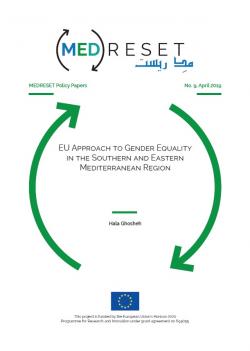EU Approach to Gender Equality in the Southern and Eastern Mediterranean Region
The EU legal and political framework reflects a strong commitment to promoting gender equality. Policy dialogue, gender mainstreaming and targeted gender programming are some of the instruments that the EU uses in “partnering countries”. There is a noticeable difference in how the EU approaches gender equality internally (within Europe) as opposed to externally (partnering countries and foreign aid), which not only reflects the economic and political “power over” approach but suggests as well that the EU is setting the gender agenda on behalf of its “partners”. The findings of this paper illustrate that the EU gender equality approach is falling short from adopting a more substantive transformative approach that would lead women to realize their “power within” to claim their rights. Furthermore, EU support to gender equality relies on short-term projects that focus on addressing “trends” determined by the international community and/or the EU priorities for the country, which undermines the substance of the international and EU agendas. On many occasions the findings show that consultations on local priorities are not sufficiently inclusive and rely on the same “favoured organizations” to inform them. The EU’s contribution to promoting gender equality was reported as insufficient, inconsistent and not responsive. MEDRESET papers indicate that gender equality was not systematically or effectively addressed in sectors of agriculture, migration, industry and energy. The mismatch between, on the one hand, the EU focus, and on the other, local priorities and addressing specific gender needs, including socio-economic needs of women, was strikingly evident. The EU role in realizing gender equality and human rights has, especially after the Arab Spring, been somewhat conflicted. EU has prioritized its self-interest and security (hidden influences and powers) over human rights and gender equality in the region. There was general agreement that the EU should “adopt a more critical stance toward human rights violations including women’s rights”.
-
Details
Rome, IAI, April 2019, 19 p. -
In:
-
Issue
Policy Paper 9
Introduction
1. Methodology
2. Conceptual Framework
Gender Equality in SEM Countries: Overview
3. Framing Gender Equality: Substance, Instruments and Actors
Gender Equality Framework: Substance
Human Rights Approach vs. a Needs Approach
Gender Equality within EU Policies and Programmes
EU Gender Equality Priorities
Level of Gender Responsiveness in Policies and Programming
Perceptions about EU Commitment to Gender Equality and Human Rights
4. Effectiveness of EU Instruments for Promoting Gender Equality
EU Gender Equality Approaches
Policy and Political Dialogue
Gender Mainstreaming
Directed Gender Equality Programming
Predetermined Scope and Defined Power
Needs Assessments, Meeting Local Needs and Addressing Inequalities
Complicated Bureaucratic Procedures
EU Partnering Actors
Characterizing Actors
Inclusiveness
Conclusion
Recommendations
References



